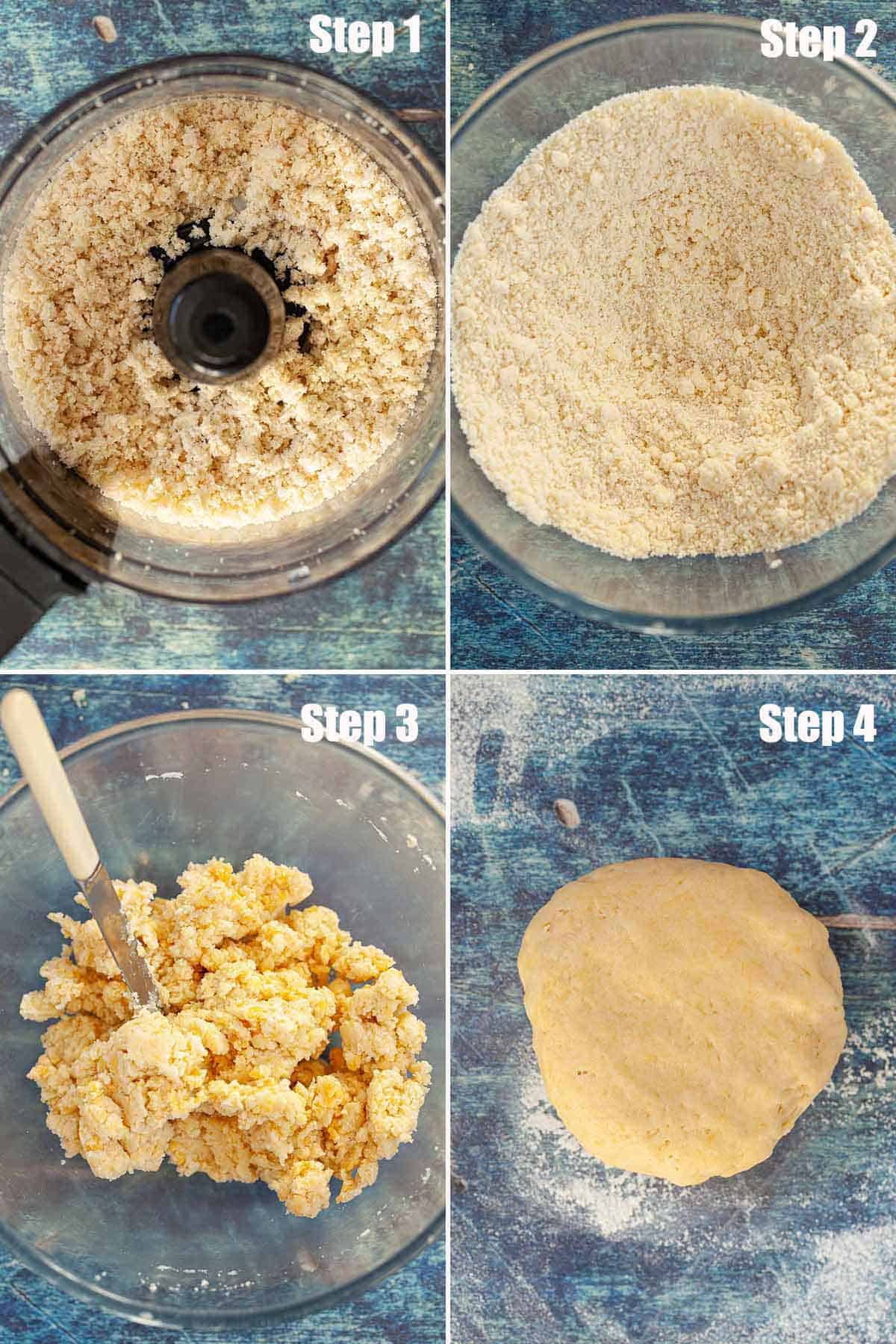Buxton pudding is an old-fashioned dessert originating from Derbyshire. Comprising shortcrust pastry, jam and a sponge topping that includes breadcrumbs, it is deliciously unique comfort food. It’s especially scrumptious with custard.
Also from Derbyshire is Thor cake, which is popular on Bonfire Night.

Want to Save This Recipe?
Jump to:
If you are looking for a cheap, easy to make and entirely different dessert to normal try your hand at Buxton pudding. This homely dessert is bound to satisfy anybody looking to satiate a sweet tooth in rustic and filling style.
This very traditional pudding hails from Derbyshire in the East Midlands. My take on this dish forms part of a growing collection of recipes from the East and West Midlands.

If you’re on the lookout for more unique desserts try Malvern pudding – it’s a lovely apple dessert from Worcestershire, also in the Midlands. Also worth a mention are Mansfield pudding (a baked suet pudding) and Northamptonshire pudding (a steamed jam pudding).
Why Buxton pudding is worth making
This nostalgic Derbyshire recipe is worth making for many reasons:
- It uses basic ingredients.
- And it’s cheap to make.
- It’s a great way to use up stale bread.
- It’s comfort food in pudding form.
- And this tart is really quite unique.
What is Buxton Pudding?
Buxton pudding originated in the Peak District spa town of Buxton in Derbyshire. It’s a rather humble classic bake dating back to Victorian times. It typically consists of:
- a crisp shortcrust pastry base.
- a layer of jam.
- and a sponge cake-style topping that includes breadcrumbs as an ingredient.
Those breadcrumbs add interest and turn this bake into something quite unique. The crust is slightly crispy but underneath the filling is soft and buttery.
This is the typical modern-day representation of the Buxton pudding, but in former times the pastry layer was not always included or it was used to line the sides of the baking dish but not the base as well. Jam was also sometimes replaced with fruit.
Note that Buxton pudding is not the same as Bakewell pudding. Although from the Peak District too, the latter is made using puff pastry, jam and a topping made from ground almonds, eggs, sugar and butter. There’s not a breadcrumb in sight.
Also, Buxton pudding is not the same as Bakewell tart which consists of shortcrust pastry, a layer of jam and a frangipane topping that is sometimes adorned with a drizzle of water icing.
Ingredients notes

As Buxton pudding uses only basic ingredients there’s no room for inferior products to hide.
Butter: make sure that you make the pastry and the topping with proper butter rather than baking margarine. This will ensure a rich and delicious flavour carries through the entire dessert.
Jam: also use the best quality jam you can lay your hands on. It makes all the difference. Aim for one with a high fruit content (at least 55% fruit per 100g). As for the flavour, I heartily recommend raspberry, but strawberry or blackberry would work very well too.
Breadcrumbs: white breadcrumbs are ideal for this pudding. Wholemeal or brown breadcrumbs could alternatively be used but the flavour will differ. I don’t recommend using sourdough as the distinctive taste would dominate too much.
Step by step instructions
- Rip the bread up, pop into a food processor and blitz until it forms breadcrumbs. Lay out on a plate and leave uncovered at room temperature.
- Mix the flour, sugar and salt together then rub in the butter.
- Add the egg yolk and 1 tablespoon of ice cold water. Use a knife to mix everything together, adding a little more water as necessary until a dough forms.
- Tip onto a lightly floured worktop and knead briefly until smooth.
- Shape into a disk, wrap in clingfilm and chill for 30 minutes.
- Roll out to 2-3mm thickness then line the tart tin.
- Line the pastry with parchment, fill to the top with baking beans (or dried lentils) and bake for 15 minutes at 180C/ 350F/ GM4. Remove the beans and parchment.

- Spread the jam over the base of the pastry case.
- Beat the butter until creamy.
- Then beat in the sugar and eggs.
- Fold the breadcrumbs in and spread the topping over the jam.
- Bake at 160C/ 310F/ Gm2½ for around 40 minutes until golden on top.

How to avoid a soggy bottom
Buxton pudding is easy to make but there is a potential pitfall – the dreaded soggy bottom. Here are a few tips to avoid it:
- If you can, use a dark metal heavy baking tin. These are best at absorbing the heat and cooking the pastry base well.
- Always use cold butter when making the pastry. Pastry that is too warm is harder to handle and does not bake as well as cold pastry.
- On a similar note, don’t skip the chilling of the dough – it helps achieve crisp pastry and stops it shrinking as it cooks.
- And don’t be tempted to skip the blind baking. It’s the best way to avoid a soggy bottomed tart.
- Put a baking sheet into the oven whilst it is heating up then sit the tart tin directly onto it whilst the pudding is baking. This also helps reduce the risk of a soggy bottom.
Frequently asked questions
Of course! I love making my own pastry but I know that not everybody shares my enthusiasm for this task. Look out for sweet shortcrust pastry in the chiller section of the supermarket. You’ll need around 300g.
Once baked leftovers should be cooled and stored in the fridge for up to 2 days.
This dessert can also be frozen. Simply cool then wrap, label and freeze for up to 3 months. Let defrost fully before serving.
Serving suggestions
This Derbyshire pudding is best served slightly warm (not piping hot).
As for what to serve with Buxton pudding, that’s entirely up to you. My personal preference is a generous portion of creamy vanilla custard. However single cream, ice cream and evaporated milk would also not be out of place alongside a slice of this humble bake.
Variations
- Don’t stick with raspberry jam, try any flavour you fancy.
- And there’s no reason why curds or marmalades couldn’t be used either.
- Alternatively, replace the jam with stewed fruit – apple and blackberry would be a wonderful combination.
- Veer wildly from the traditional Buxton pudding by including some desiccated coconut in the breadcrumb topping. Try mixing in 2-3 tablespoons.

More old-fashioned bakes to make
If you’re pining for more humble bakes that have been knocking around for donkey’s years, try these:
Have you made my Buxton pudding recipe? Did you know commenting and rating recipes is one of the best ways you can support your favourite food bloggers? Let me know what you think of this recipe in the comments below and don’t forget to show me a picture of it on Instagram – use #littlesugarsnaps and tag me @jane_littlesugarsnaps.
📖 Recipe
Want to Save This Recipe?

Buxton Pudding
Equipment
- 1 8-inch (20cm) loose-bottomed tart tin approx 3cm deep
Ingredients
For the Pastry
- 150 g Plain flour (all-purpose)
- 30 g Caster sugar
- 75 g Butter cold
- 1 Egg yolk free-range
- 1 tablespoon Water ice-cold
For the filling
- 5 tablespoons Raspberry jam
- 100 g Butter softened
- 100 g Caster sugar
- 100 g White bread stale
- 2 Eggs large, free-range
Instructions
Make the breadcrumbs
- Rip the bread up, pop into a food processor and blitz until it forms breadcrumbs.
- Lay out on a plate and leave uncovered at room temperature while you make the rest of the pudding.
Make the Pastry
- Mix the flour, sugar and a pinch of salt together then rub in the butter until it resembles fine breadcrumbs.
- Add the egg yolk and 1 tablespoon of ice cold water. Use a knife to mix everything together, adding a little more water as necessary until a dough forms.
- Tip onto a lightly floured worktop and knead briefly until smooth (about 30 seconds). Don't knead too much as the gluten in the flour will develop and turn the pastry rubbery.
- Shape into a disk, wrap in clingfilm and chill for 30 minutes. Meanwhile put a flat metal baking sheet inside of the oven and preheat the oven to 180C/ 350F/ GM 4.
Blind Bake the Pastry
- On a lightly floured work surface roll the pastry out to 2-3mm thickness then line the tart tin.
- Line the pastry with parchment, fill to the top with baking beans (or dried lentils) and transfer to the hot baking sheet inside of the oven. Bake for 15 minutes. Remove the beans and parchment.
- Turn the oven temperature down to 160C/ 310F/ GM 2½.
Make the Filling
- Spread the jam over the base of the pastry case.
- Beat the butter until smooth and creamy – use electric beaters.
- Then beat in the sugar and eggs.
- Fold the breadcrumbs in and spread the topping over the jam, ensuring it reaches the edges of the pastry case.
- Put the tin back in the oven, again on the metal baking sheet and cook for around 40 minutes until golden on top.
Notes
- You can use readymade pastry. Try to pick up sweetened shortcrust pastry. You’ll need around 300g.
- If you can, use a dark metal heavy baking tin. These are best at absorbing the heat and cooking the pastry base well.
- Always use cold butter when making the pastry. Pastry that is too warm is harder to handle and does not bake as well as cold pastry.
- On a similar note, don’t skip the chilling of the dough – it helps achieve crisp pastry and reduces the chance of it shrinking during cooking.
- And don’t be tempted to skip the blind baking. It’s the best way to avoid a soggy bottomed tart.
- Put a baking sheet into the oven whilst it is heating up then sit the tart tin directly onto it whilst the pudding is baking. This also helps reduce the risk of a soggy bottom.
- Once baked leftovers should be cooled and stored in the fridge for up to 2 days.
- This dessert can also be frozen. Simply cool then wrap, label and freeze for up to 3 months. Let defrost fully before serving.












Derryth Hope
As someone who lived in the Peak District (the area of Derbyshire where the desert comes from) I think it is more commonly known as Bakewell pudding. Sometimes wrongly called Bakewell tart, but always Bakewell here in England.
It’s fascinating that the name has changed in the US Buxton is quite a small town (as is Bakewell) I wouldn’t have thought either would be well known on that side of the Atlantic.
Jane Saunders
Hi Derryth, thanks for your message. This one is definitely Buxton Pudding. I’m currently working on a Bakewell Pudding (not tart!) recipe. It’s a little different to the Buxton Pud shown here as it has a puff pastry case, contains no breadcrumbs, significant amounts of egg and some almond (it’s very different to a Bakewell tart though). I’m still perfecting the recipe and will be publishing when I’ve done so. It seems that Bakewell and Buxton have both blessed us a very delicious pudding for us to enjoy. As for the popularity of the Bakewell tart… could that be the Mr Kipling effect?
Michele
How much bread do you use?
Jane Saunders
Hi Michele – you’ll need 100g of breadcrumbs – full details (including all measures) are in the recipe card at the bottom of the post.
Sue
This is a Bakewell tart !!
Jane Saunders
Hi Sue – thanks for your comment. The Buxton pudding is a little different to a Bakewell Tart as a Bakewell tart is made using ground almonds to create a frangipane layer. A Buxton pudding does not contain almonds at all. The spongy layer is created from breadcrumbs. Hope that helps clarify the difference between the two delicious desserts from Derbyshire. All the best – Jane.